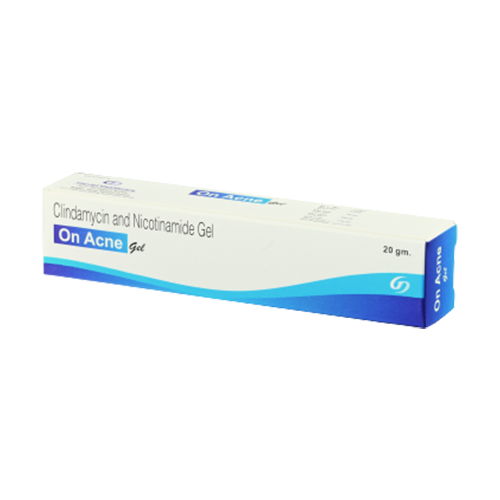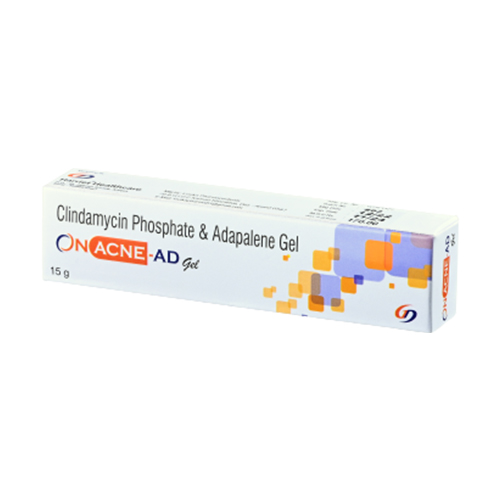Clindamycin and Nicotinamide Gel
ONACNE

Clindamycin and Nicotinamide Gel: are topical acne treatments. Clindamycin is an antibiotic that aids in the reduction of acne-causing bacteria on the skin. It works by slowing their growth and decreasing inflammation. Nicotinamide, a kind of vitamin B3, aids in the improvement of the skin’s barrier function and the reduction of excess oil production. These chemicals work together to address the underlying causes of acne. Including bacterial overgrowth and inflammation, they clean up existing acne lesions and prevent new ones from forming. As instructed by a healthcare practitioner, the gel is normally administered to the affected areas of the skin once or twice daily.
Benefits of Using Clindamycin and Nicotinamide Gel
The following are some of the primary advantages of using Clindamycin with Nicotinamide Gel to treat acne:
- Clindamycin in the gel kills or inhibits the growth of acne-causing bacteria, lowering the number of bacteria on the skin.
- Both have anti-inflammatory characteristics, which assist to lessen the redness, swelling, and inflammation associated with acne.
- Nicotinamide regulates sebum production, which can contribute to clogged pores and acne breakouts. It helps prevent the growth of new acne lesions by lowering excessive oil production.
- It also maintains the skin’s natural protective barrier, boosting its capacity to retain moisture and defend against external stresses. This can help to reduce the skin sensitivity and irritation that is commonly linked with acne.
- Combination approach: The gel’s synergistic impact targets various components involved in acne production, including bacteria and inflammation, resulting in more effective acne control.
- Convenience: the Gel is a topical treatment that can be applied directly to problematic areas. It is simple to incorporate into a skincare routine.
How Clindamycin and Nicotinamide Gel Works
Clindamycin+Nicotinamide Gel efficiently cures acne by combining the antibacterial and anti-inflammatory characteristics of the gel. This is how it works:
- The gel contains an antibiotic that suppresses the growth of acne-causing bacteria, specifically Propionibacterium acnes. It reduces inflammation and prevents the production of new acne lesions by decreasing the bacterial population on the skin.
- Nicotinamide, a kind of vitamin B3, aids in the regulation of sebum production. Excessive sebum production might contribute to clogged pores and acne breakouts. It also helps prevent the production of new acne lesions by regulating sebum levels.
- Anti-inflammatory properties: Clindamycin and Nicotinamide are both anti-inflammatory. Clindamycin decreases acne inflammation by inhibiting the activity of inflammatory mediators. Nicotinamide soothes the skin by reducing redness and edema.
How to Use Clindamycin and Nicotinamide Gel
Clindamycin+Nicotinamide Gel usage instructions may differ depending on your healthcare provider’s recommendations. However, here is a broad application guideline:
- Start by cleansing your face with a light cleanser to remove any grime, oil, or makeup. Use a clean cloth to pat your skin dry.
- Apply a little amount of gel (about the size of a pea) to the damaged parts of your skin.
- Massage or distribute the gel in a thin layer over the acne-prone area, making sure it covers the entire area.
- Take care not to get the gel in your eyes, lips, nose, or mouth. If inadvertent contact occurs, thoroughly rinse with water.
- After applying the gel, thoroughly wash your hands with soap and water to remove any residue.
- Follow the advice supplied by your healthcare expert regarding the frequency of application.
- The gel is typically used once or twice daily. To achieve the best results, stick to the recommended frequency.
- Use the gel for the full term prescribed by your healthcare practitioner, even if you notice improvements in your acne. Stopping treatment abruptly may allow acne to reappear.
- After the gel has dried, you may use other non-comedogenic skincare products, such as moisturizers or sunscreens, if prescribed by your healthcare expert.
Precautions While Using Clindamycin and Nicotinamide Gel
It is critical to remember the following precautions when using Clindamycin with Nicotinamide Gel:
- Allergic reactions: If you have a known allergy to clindamycin, nicotinamide, or any other ingredients in the gel, stop using it and get medical treatment if you develop a rash, itching, swelling, or difficulty breathing.
- The gel should not come into touch with your eyes, lips, nose, or mouth. In the event of an accident, thoroughly rinse with water.
- The Gel may increase the sensitivity of your skin to sunlight. During therapy, wear sunscreen and protective clothing and prevent excessive sun exposure.
- To avoid potential drug interactions, inform your healthcare practitioner about any additional topical or oral medications you are using.
- If you are pregnant, expecting to become pregnant, or breastfeeding, see your healthcare practitioner before using the gel.
- At first, mild skin irritation or dryness may occur. If you experience extreme irritation, redness, or itching, stop using the product and visit your doctor.
- For optimal results, use the gel as instructed by your healthcare expert and stick to the specified treatment time.
| Pack Size | 20 GM |
|---|---|
| Packing Type | LAMI TUBE |
| Composition |



